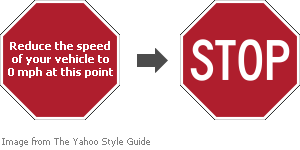![]()
“The biggest problem with communication is the illusion that it has been accomplished.” George Bernard Shaw
“Why don’t they understand the instructions?”
“How come we get so many calls when it is time for people to renew their licenses?”
“I can’t find anything on that website that even remotely sounds like what I need!”
Sound familiar? Maybe you’ve experienced this as a citizen trying to use government services. Or you’ve heard these complaints coming into your office every day. What gives? Maybe the language used to communicate isn’t plain enough.
History
Efforts in the United States to make government documents more readily understandable and useful have been around since the late 1940s. Additional momentum was gained via Presidents Nixon and Carter throughout the 1970s. The 1990s saw a resurgence of interest when President Clinton issued a Presidential Memorandum. Today, there are Federal requirements for using Plain Language. Many states have their own Plain Language statutes addressing how forms and communications are developed.
Three Easy Tips
- Write the way you would talk to the person if they were in the same room.
Ever go back and forth with someone via email three or four times, only to be frustrated that they don’t understand you? So you call them and after listening to just a few sentences they say, “Why didn’t you tell me that! NOW I get it.” Write the way you would talk to the person if they were in the same room. Many of us are brilliant conversationalists until we sit in front of a computer. Somehow then we are compelled to use big, arcane words, insider acronyms, and a language only a few may know.
2. Tell a short story to provide the ‘why’
A patient enters a hospital for knee surgery. The admissions nurse asks for his name, address and confirms why he is here. The nurse that brings him to the surgery area asks the patient for his name, address and confirms why he is here. As he is being prepped for surgery, the doctor asks him for his name, address and confirms why he is here. The patient thinks these people are nuts and don’t know who he is! What if the admissions nurse said, “I need to verify your name, address and why you’re here to be sure we do everything right. As you move through your surgery day, several other people will ask you the same questions. This is for your safety.” The story helps.
3. Use images and graphs
Images and graphs in presentations, forms, and websites can make the experience of our customers easier and efficiently get them what they want. Check this one out:

Be sure to always follow Federal accessibility standards and your state’s guidelines when using images and graphs.
Next time you have to communicate, internally or externally, remember these three easy tips. The effort you put into Plain Language will greatly increase the opportunity that your message will be heard, understood, and acted upon!
Does Plain Language make a difference?
It does in Federal government: [Read More]
It does in Minnesota: [Read More]
Resources
Sam Snoop – the Plain Language sleuth!
A Minnesota Plain Language rules manual
What’s Next?
Over the next 12 weeks I am writing about how we can improve our work for the benefit of the people we serve. In Minnesota, it’s what we call “Better Government for a Better Minnesota” and in my division it’s how we “solve problems that change lives.”
Are you a Govie who is interested in “solving problems that change lives”? Please join me on this journey and let’s chat!
– Joe
###
Joe Raasch is part of the GovLoop Featured Blogger program, where we feature blog posts by government voices from all across the country (and world!). To see more Featured Blogger posts, click here.




Thanks Joe, great article. One thing I’ve learned is put the instructions up front, most of my readers don’t care about the history or background so I edit that quite a bit and put it after the “meat and potatoes”.
Thanks Brenda! I agree, most people want the answer or instructions up front and more detailed context to follow. You bring up a great application of Plain Language that can be used in a variety of communications.
Great article and even better timing! I’m just starting a Plain Language program in my organization, so I’ll be sharing this with everyone. Thank you!
Thanks Mike! Contact me directly if there is anything you’d like to know about our experience with our Plain Language program in Minnesota. Good luck!
Good tips and love the resources especially. Thanks for sharing!
Thanks Hannah! Let me know if you need any additional info.
Great information, thanks Joe! I have also found if I include bullet points in my e-mails, (With plain language, of course!), it makes them even easier for people to understand what I am trying to say.
Absolutely Lori! Bulleted lists improve understanding.
Great post Joe! I’ve got that same George Bernard Shaw quote hanging in my cube! It is so true.
Congratulations on being a “Featured Blogger” – good to see the Minnesota perspective being represented!
Thanks Greg! Like minds…
I look forward to hearing more, especially thoughts about using pronouns, such as “you,” “he/she,” etc., when we write procedures. How do you explain it to staff who are uncomfortable with using pronouns?
Hi Esther, great question. I’ve had similar challenges with staff. The exercise of “write the way you would talk to the person if they were in the same room” can help ease people into plain language.
Plain language is *sometimes*, but not always, the same thing as a clear explanation. Not that clear explanations *shouldn’t* use plain language, but often one can follow every conceivable tip for making language plainer, and things still aren’t any clearer. The sad reality is that very few of us, no matter how far up the educational ladder we go, receive any sort of formal instruction on *explaining*. If you’ve ever had to grade undergraduate exams or essays, you’ll know just how prevalent that shortcoming is in society.
Some years back, I was tasked with teaching a community college class comprised largely of computer science students. I won’t go into the overall curriculum, but in an effort to rectify the dearth of training students get in explaining, one of the modules I incorporated was on writing documentation. It was prompted by a talk I attended given by eminent text-comprehension authority Walter Kintsch ( http://psych.colorado.edu/~wkintsch/ ). During his talk, Kintsch noted that he had shortly-before had reason to consult the documentation for a piece of software purchased some years earlier. Much to his surprise, and in contrast with what he often heard others complain about, he found it to be quite well-written. BUT, he noted, it was written from the perspective of an expert, anticipating the moment-to-moment information needs of an expert. And that is sort of the perpetual challenge of writing explanations, instructions, or documentation for anything we have been a little too close to for a little too long. We think in terms of what WE know and anticipate; having a much harder time anticipating what the novice is thinking and expecting. (Hence the origins of the various “For Dummies…” and “Complete Idiot’s Guide” series, that attribute comprehension failure to the learner, instead of the writer, where such blame properly lies.)
Armed with that insight, I brought a video projector to class so that we could collaboratively write documentation. I selected something that everybody in the class knew extremely well, and would have a hard time “de-experting” themselves from. One year we wrote instructions for how to play Monopoly, and the next year we did Scrabble. The assumption was that they were writing for someone who knew a bit about board games, but had never played either of the two mentioned. To be frank, it was hard work for them. The hardest part was restraining themselves from wanting to race ahead to the complex fancy stuff. I had to keep asking them constantly “Does the beginning player want or need to know that right now?”, “What question are they likely to have at the moment?”, “Would that information be of more value to them if you held off for a bit?”.
And often, those sorts of questions make the difference between something being plain and unclear, or plain and clear. Imagining what the reader wants to *know*, rather than thinking about what you want to tell them, can make a huge difference in your writing. I suspect a useful exercise for nearly any sort of expository writing is to first approach it as if you were constructing an FAQ document. One can then generate a list of information needs of the typical anticipated reader, and sequence those questions in the order that you think they might crop up in the reader’s mind. By presenting the information in a sequence dictated by the reader’s moment-to-moment information needs, it will make far more sense to them. Of course, don’t forget to keep your language simple.
Thanks Mark for your input. I like the idea of using a hands-on an instructional approach to teaching Plain Language/writing clearly. The examples of the challenges to writing instructions for how to play Scrabble, etc. are helpful!